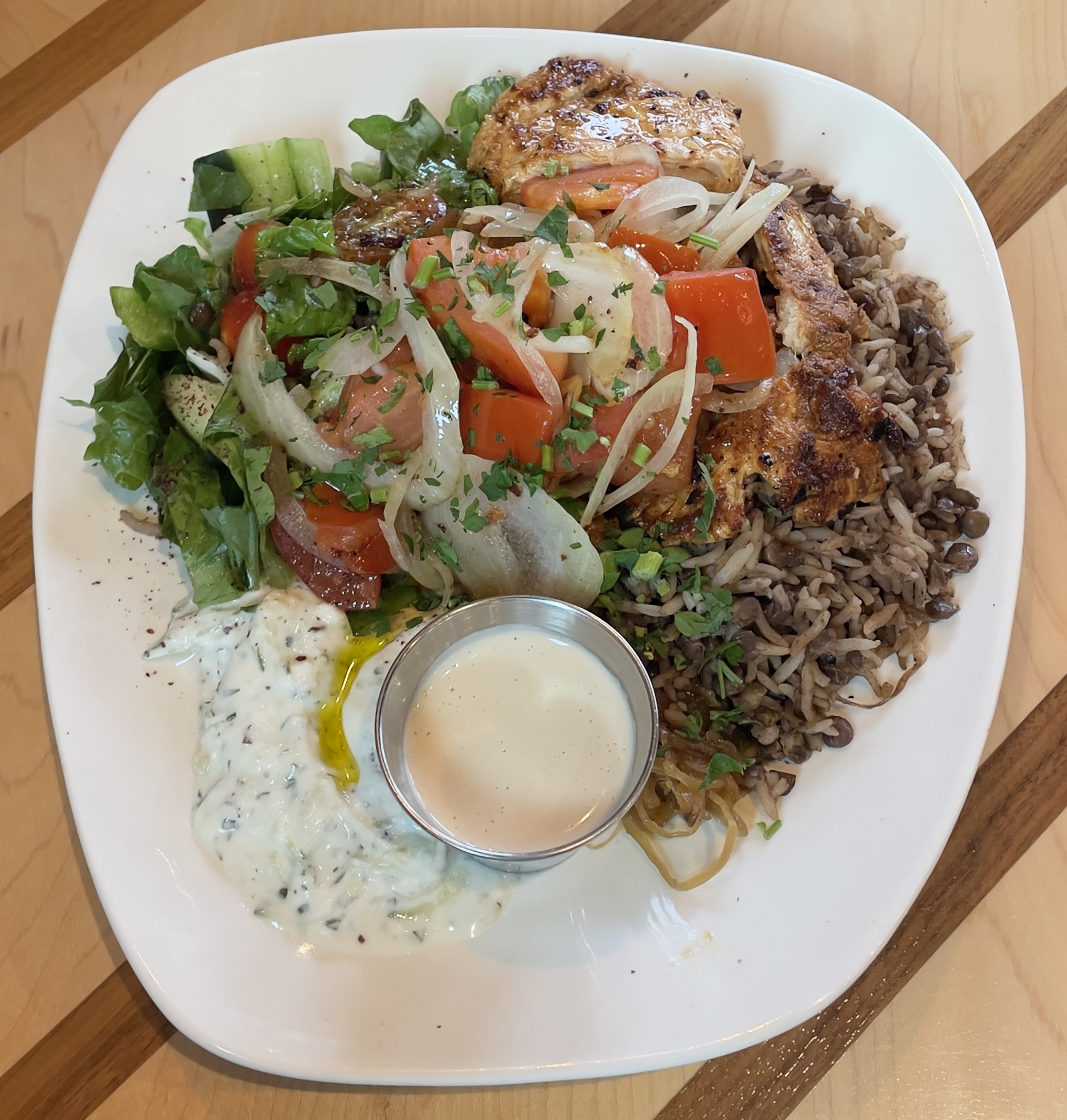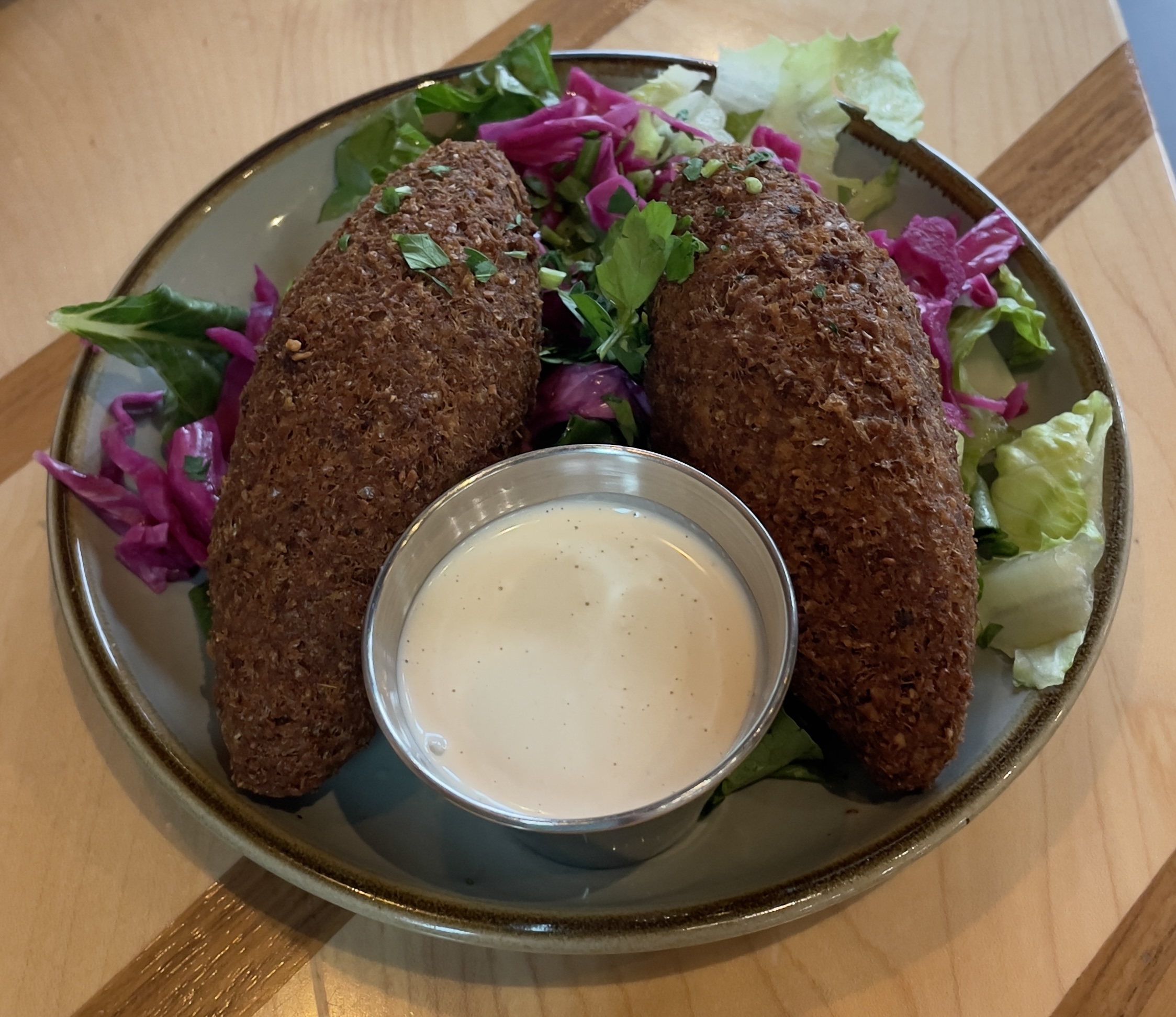
Laziz Kitchen
He said:
Laziz Kitchen is a warm, inviting place named after its owner, Derek Kitchen1. Its modest downtown dining room has one wall of windows looking out onto 200 South Street, one wall of timeless brick, one wall of geometric panels, and the other side opens to the countered area in front of the kitchen. Live plants sprawl across shelves and planters throughout the space. A Devil’s Ivy plant sprouted from a glass vase on our small table.
Our table was disappointingly small, intended for just two people. Still, I would have liked a little more room, especially as the table abutted directly against the brick wall. There was only one other patron in the dining room, so surely they could have spared a larger table for us.
The menu had plenty of interesting things to try, many with names and descriptions that were unfamiliar to me. I wish I could have sampled them all. We began by ordering the Sampler Dip Plate, served with Warm Pita and Fresh Veggies. For it, we chose three dips: Hummus, Baba Ghannouj, and Muhammara.
The Dips Sampler came on a small tray with spears of romaine, carrots, and cucumbers lining one side, wedges of pillowy-soft pita bread on the other, with a tri-section bowl of purees in the middle. The Hummus was good, but ordinary. The Baba Ghannouj, on the other hand, was much more exotic. Its earthiness combined a slightly smoky flavor from fire-roasted eggplant with the creamy nuttiness of tahini, and was balanced by garlic and lemon. My favorite of the dips was the Muhamarra. This one also had a slightly smoky flavor due to roasted red peppers, but it was much brighter and more than a little sweeter. Some of that might have come from the peppers, but I’m sure the pomegranate molasses also contributed. Onions and garlic rounded it out, with chopped walnuts on top.

We also ordered a Mezze (small plate). At least four of these caught my eye, so I asked the waitress to help us decide. She recommended the fried cauliflower. That sounded great to me, but I wanted to try something I hadn’t had before, so I decided to order the Kibbeh. I didn’t know what that was, though the menu called it the national dish of Lebanon.
Kibbeh is a deep-fried meat pie, shaped a bit like a football. In fact, its color was similar to a football, as well. I expected a doughy crust, but the crust was much more subtle and thin. My first bite was a surprise. I’m not sure exactly what I expected, but I hadn’t expected cinnamon! It wasn’t strong or overpowering—in fact, it took Kathy a moment to detect it. Instead, it was a warm enhancement to the savory appetizer.
For my entrée, I had wanted to order the Shakshuka from the moment I first spied it on the menu. However, Kathy beat me to it, so I decided to explore the rest of the menu. I settled on the Lebanese Platter. It included a house salad with plenty of onions, tomatoes, and cucumbers. It also had some Tzatziki that was so creamy and mellow that I wondered if it had been made with labneh instead of yogurt. If so, I definitely approve. My long-grain rice was full of plump brown lentils and seasoned with the mildly warming embrace of cloves. The breast of chicken was juicy and delightfully seasoned.

My entire lunch was a lovely tour of Lebanese cuisine. The service was friendly and efficient, and the food came to us without delay.
She said:
Stepping into the Laziz Kitchen was a welcome relief from a cloudy, cold Saturday afternoon in SLC. A stunning counter graced the back of the restaurant. It was clad in glossy subway tiles that had been installed vertically and finished with dark grout, while the façade was crafted of light-colored wood. The tile was repeated on the wall behind it. Sunny yellow mugs rested on a rack in the corner of the countertop.
After taking that in, my eye was drawn to the dining room itself. Golden-colored tables, golden wood booth benches with gray cushioned backs, rich orangey, tan-colored leather chairs, a black counter in front of the windows with tall stools, potted ferns and ivies. It was all modern and chic, but also warm and inviting. I felt immediately at ease.
We were greeted by a friendly waitress who handed us paper menus. She gave us adequate time to peruse them before asking for our beverage and appetizer orders. We didn’t wait long for our diet Cokes, dip sampler, and Kibbeh. The soda was good, the dips were delicious (my favorite was the hummus for its creaminess and nutty undertones), and the warm pita triangles were comforting and filling, while the crisp crunchiness of the carrot sticks and cucumber spears was satisfying. The Kibbeh, on the other hand, was a culinary revelation for me because I’ve never had the pleasure of eating it before.

It was served on a bed of fresh, shredded lettuce and shredded, pickled purple cabbage, with a side of sauce for dipping. As Brian said, it was like a miniature, football-shaped, brown-colored meat pie filled with ground beef and lightly seasoned with cinnamon. It was scrumptious and totally defied our waitress’s description of it being “like a Twinkie, except with a meat filling.” (I sort of chuckled at that).
My entrée, as previously mentioned, was the Shakshuka. The reason I ordered it was because I’ve enjoyed the vegetarian version my hubby has prepared and served at home. I figured that an authentic Lebanese dish would be exceptional. And it was pretty close. My meal was brought to me in a small cast iron skillet that sat on a wooden cutting board that held seasoned pita triangles on the side. It was so beautifully presented and smelled so delicious that I couldn’t wait to dig in. There were two large lamb meatballs and two baked eggs sitting on top of a sauce consisting of tomatoes, feta, honey, and cilantro. The eggs were perfectly cooked, and the meatballs were tasty, but one thing brought my enjoyment of the dish down a notch. The menu had hailed the sauce as “robust,” which I interpreted to mean richly flavorful, but the chef must have defined it as being spicy. So, unfortunately, the bulk of the sauce stayed in the skillet while I nibbled on the eggs and meat that were unscathed by the acute burn of the spices.

Overall, I thoroughly enjoyed my meal from start to finish. The food was excellent and plentiful, and the service was quick and impeccable. I want to go back to try other dishes and ask if they serve dessert.
Conclusion:
For a delightful culinary tour of Lebanon, be sure to pay Laziz Kitchen a visit!
-
Really, that’s his name, though I can only guess that he is the restaurant’s eponym. It reminds me of one of my high school teachers who would frequently say things like, “Here we’ll use the Planck Constant, named after its inventor, Mr. Constant.” Meanwhile, “Laziz” is an Arabic word for “tasty” or “lighthearted.”↩